
Daniel Chester French was an American sculptor in the late 19th and early 20th centuries. His works include the The Minute Man, an 1874 statue in Concord, Massachusetts, and his 1920 monumental statue of Abraham Lincoln at the Lincoln Memorial in Washington, D.C.

The Wang Theatre is a theatre in Boston. It originally opened in 1925 as the Metropolitan Theatre and was later renamed the Music Hall. It was designed by Clarence Blackall and is located at 252–272 Tremont Street in the Boston Theatre District. The theatre is operated as part of the Boch Center. The theatre was designated as a Boston Landmark by the Boston Landmarks Commission in 1990.

The Isabella Stewart Gardner Museum is an art museum in Boston, Massachusetts, which houses significant examples of European, Asian, and American art. Its collection includes paintings, sculpture, tapestries, and decorative arts. It was founded by Isabella Stewart Gardner, whose will called for her art collection to be permanently exhibited "for the education and enjoyment of the public forever."

The Back Bay Fens, often called The Fens, is a parkland and urban wild in Boston, Massachusetts, United States. It was established in 1879. Designed by Frederick Law Olmsted to serve as a link in the Emerald Necklace park system, the Fens gives its name to the Fenway-Kenmore neighborhood.

Quincy Market is a historic building near Faneuil Hall in downtown Boston, Massachusetts. It was constructed between 1824 and 1826 and named in honor of mayor Josiah Quincy, who organized its construction without any tax or debt. The market is a designated National Historic Landmark and a designated Boston Landmark in 1996, significant as one of the largest market complexes built in the United States in the first half of the 19th century. According to the National Park Service, some of Boston's early slave auctions took place near what is now Quincy Market.

The Landmark Center or 401 Park Building in Boston, Massachusetts is a commercial center situated in a limestone and brick art deco building built in 1928 for Sears, Roebuck and Company. It features a 200-foot-tall (61 m) tower and, as Sears Roebuck and Company Mail Order Store, it is listed on the National Register of Historic Places and designated as a Boston Landmark in 1989.

The Converse Memorial Library – also known as Converse Memorial Building – is a historically significant building designed by noted American architect Henry Hobson Richardson. From 1885 to 1996, it housed the Malden Public Library, which now occupies a modern building adjacent to it. The former library is located at 36 Salem Street, Malden, Massachusetts.

The First Church of Christ, Unitarian, also known as First Church of Lancaster and colloquially as "the Bulfinch Church", is a historic congregation with its meeting house located at 725 Main Street facing the Common in Lancaster, Massachusetts. The church's fifth meeting house, built in 1816, was designed by architect Charles Bulfinch, and was designated a National Historic Landmark in 1977, recognizing it as one of Bulfinch's finest works.
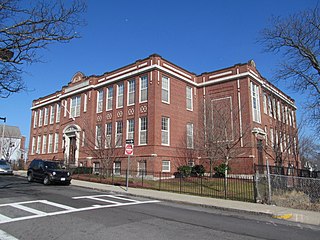
The Benedict Fenwick School is a 1912 historic school building at 150 Magnolia Street in Boston, Massachusetts. The Classical Revival brick school building was designed by Boston architect James E. McLaughlin, who also designed Fenway Park, the Commonwealth Armory in Boston, and the Hudson Armory in Hudson, Massachusetts. It was named for Benedict Fenwick, the second bishop of the Roman Catholic Archdiocese of Boston. The city used it as a school until 1981. It was purchased by the American Muslim Mission and opened the following year as the Sister Clara Muhammad School, named for Clara Muhammad, the first wife of Nation of Islam founder Elijah Muhammad. In 1999, it was acquired by a developer and converted to housing.
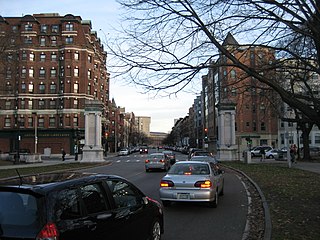
The Fenway-Boylston Street District is a historic district encompassing a series of predominantly residential buildings lining The Fenway in the Fenway–Kenmore of Boston, Massachusetts. Developed beginning in the 1890s, the area is emblematic of Boston's upper-class residential development of the period, with architect-designed houses built for some of the city's leading families. The district was listed on the National Register of Historic Places in 1984.
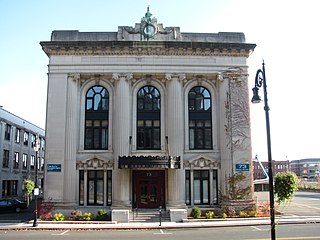
The United Electric Co. Building was a historic commercial building at 73 State Street in Springfield, Massachusetts. One of the city's few Beaux-Arts buildings, it was built in 1910 to serve as the headquarters of the United Electric Company, Springfield's supplier of electricity since the 1880s. It was listed on the National Register of Historic Places in 1983. It has been mostly demolished, preserving the facade as part of the MGM Springfield casino project.

George Loftus Noyes (1864–1954) was a Canadian born artist who gained fame in the early 20th century as an American Impressionist.
J. Harleston Parker was an American architect active in Boston, Massachusetts.
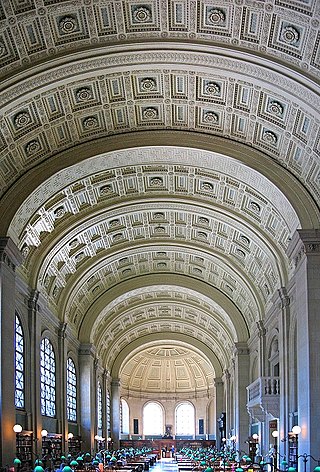
The McKim Building is the main branch of the Boston Public Library at Copley Square in Boston, Massachusetts. The building, described upon its 1895 opening as a "palace for the people", contains the library's research collection, exhibition rooms, and administrative offices. The building includes lavish decorations, a children's room, and a central courtyard surrounded by an arcaded gallery in the manner of a Renaissance cloister. The library regularly displays its rare works, often in exhibits that will combine works on paper, rare books, and works of art. Several galleries in the third floor of the McKim building are maintained for exhibits.
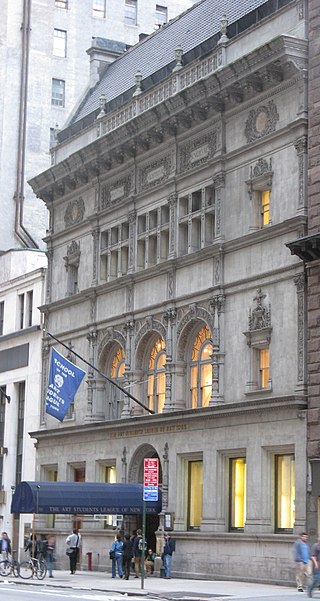
The Art Students League of New York Building is a building on 57th Street in Midtown Manhattan in New York City. The structure, designed by Henry Janeway Hardenbergh in the French Renaissance style, was completed in December 1892 and serves as the headquarters of the Art Students League of New York. The building was developed by the American Fine Arts Society (AFAS), formed in 1889 by five organizations including the Art Students League, the Society of American Artists, and the Architectural League of New York.
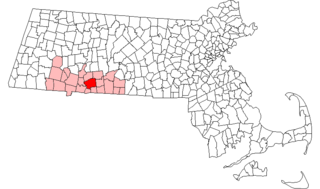
This is a list of the National Register of Historic Places listings in Springfield, Massachusetts.

Parker, Thomas and Rice and Parker & Thomas were architectural firms formed in the early 20th century by partners J. Harleston Parker, Douglas H. Thomas, and Arthur W. Rice.

The John W. McCormack Post Office and Courthouse, formerly the United States Post Office, Courthouse, and Federal Building, is a historic building at 5 Post Office Square in Boston, Massachusetts. The twenty-two-story, 331-foot (101 m) skyscraper was built between 1931 and 1933 to house federal courts, offices, and post office facilities. The Art Deco and Moderne structure was designed in a collaboration between the Supervising Architect of the United States Treasury Department and the Boston architectural firm of Cram and Ferguson. It occupies a city block bounded by Congress, Devonshire, Water, and Milk Streets, and has over 600,000 square feet (56,000 m2) of floor space. The exterior of the building is faced in granite from a variety of New England sources, as well as Indiana limestone. It was built on the site of the 1885 United States Post Office and Sub-Treasury Building.
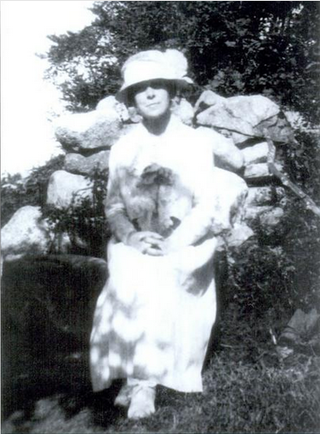
Mary Brewster Hazelton was an American portrait painter. She attended the School of the Museum of Fine Arts, Boston, where she was later an instructor. Among her other achievements, Hazelton was the first woman to win an award open to both men and women in the United States when she won the Hallgarten Prize from the National Academy of Design in 1896. Her portrait paintings are in the collections of the Massachusetts State House, Harvard University, Peabody Essex Museum, and Wellesley Historical Society. The professional organizations that Hazelton was affiliated with included the Wellesley Society of Artists, of which she was a founding member, and The Guild of Boston Artists, of which she was a charter member. She lived her adult life with her sisters in the Hazelton family home in Wellesley, Massachusetts.























